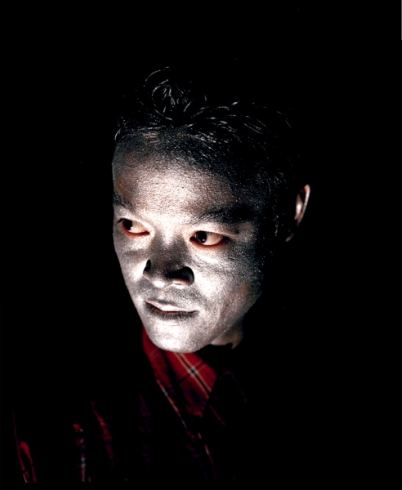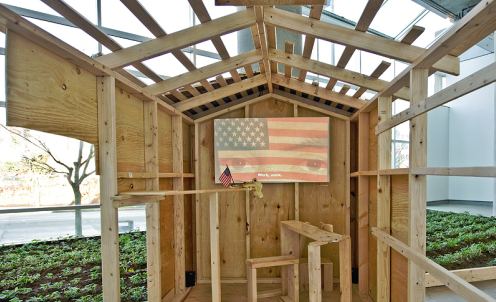In Tokyo the rush hour is silent. People pour from buildings to cross streets, coming
and going in comparatively quiet surges. If a salary man heading home from a late night of drinking stumbles and falls in the street, he is not likely to break into song.
The desire to keep oneself to oneself has practical roots. In the 17th century, for instance, pioneers of the merchant class learned to avoid angering the samurai with overt displays of wealth. Even the most successful shop owners wore coarse cotton jackets in dark colors. Inside, however, the jackets were lined in richly colored silks embroidered with peonies, cranes and craggy pines.
Following in a long line of Zen priests and Neo-Dada figures such as Ushio Shinohara, Meiro Koizumi is extraordinarily good at cracking an emotionally impassive surface. Once the surface is cracked, he’s the equivalent of a crime scene reporter at Bruce Nauman’s Clown Torture, not as interested in the wailing as in the reasons for it.
 Thanks to curator Yoko Ott, there are two opportunities for depth viewing of Koizumi’s production: My Voice Would Reach You, A Survey of his First Ten Years, 2000-2009 at Seattle University’s Hedreen Gallery, and The Corner of Sweet and Bitter at Open Satellite.
Thanks to curator Yoko Ott, there are two opportunities for depth viewing of Koizumi’s production: My Voice Would Reach You, A Survey of his First Ten Years, 2000-2009 at Seattle University’s Hedreen Gallery, and The Corner of Sweet and Bitter at Open Satellite.
Two from Hedreen:
Mum features a young man on the phone listening to his mother. From his responses, we know it’s a series of button-down mom exchanges.The sun is shining; Dad’s working hard; she wonders if her son ate the vegetables she sent him. He mumbles through his end of the conversation but tells her he has something to say. After the conventional set up, the impact of his visceral performance is profound. It’s the deep end of the emotional ocean.
For Human Opera XXX, Koizumi placed at ad in a Northern European newspaper, asking for volunteers willing to be filmed as they tell a sad life story. The piece is an engagement between subject, artist and camera. As the volunteer speaks, Koizumi insists he continue his tale with props to provide appropriate resonance. From love affair to daughter to drinking problem to sobriety to utter loss, the man reluctantly allows Koizumi to enfold him in props that peel the skin off his story.
 The Bellevue Problem: Plenty of people in Seattle go to the Hedreen Gallery or are at least theoretically willing to go to the Hedreen Gallery and hope they remember before this show closes. Only a fraction of those see the need to go to Open Satellite, because it’s in Bellevue. Besides, if ten years of the artist’s work is in Seattle, why cross Lake Washington to see a single piece from far, far away?
The Bellevue Problem: Plenty of people in Seattle go to the Hedreen Gallery or are at least theoretically willing to go to the Hedreen Gallery and hope they remember before this show closes. Only a fraction of those see the need to go to Open Satellite, because it’s in Bellevue. Besides, if ten years of the artist’s work is in Seattle, why cross Lake Washington to see a single piece from far, far away?
Because it’s an installation rooted in Northwest history. Its cities were not built on rock and roll but on the labor of Asian immigrants. Japanese-Americans cleared the ground in Bellevue and Vashon Island for farmlands, uprooting stumps and planting endless rows of strawberries. Although Vashon Island still celebrates its roots with an annual Strawberry Festival, there are no commercially grown strawberries on the island since World War II. On Feb. 19, 1942, with Executive Order 9066, Japanese and Japanese Americans living on the West Coast were arrested and relocated to internment camps.Who was willing to do the back-breaking labor after they left? Apparently, nobody.
To honor them, Koisumi half-built a house and surrounded it with strawberry fields. Inside the house is a video screen. A young Mexican American plays The Star Spangled Banner on a homemade trumpet taped to his mouth. As he plays, the American flag ripples across his face.The text is a stream of admonitions to work hard. With noses to grindstones and shoulders to wheels, efforts are rewarded, right? The cumulative effect of this piece is overwhelming.
(Photos: Malcolm
Smith)

 Both exhibits through Jan. 9.
Both exhibits through Jan. 9.



Bellevue is far, far away from Seattle? It’s 10 minutes by car, 20 by bus. What are you talking about?
Ellen. You’re describing times without traffic. And I was thinking of psychic distance, a perception of distance.
to misquote William Burroughs-
when I think of the bellevue, thats when I reach for my tactical nuclear weapons….